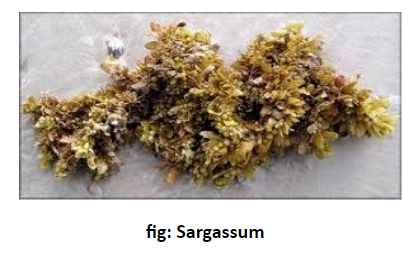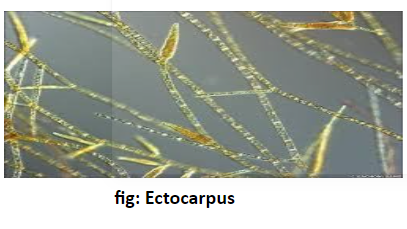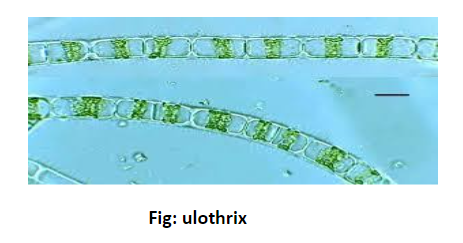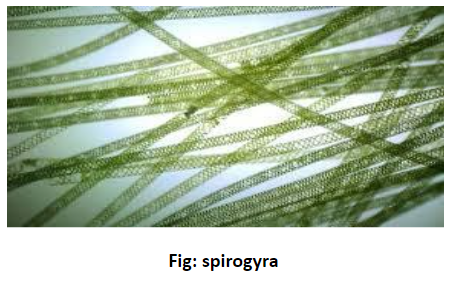
Which of the following shows isogamy with non-flagellated gametes?
A. Sargassum
B. Ectocarpus
C. Ulothrix
D. Spirogyra
Answer
475.5k+ views
Hint: It is a filamentous charophyte green algae of the order Zygnematales.
It is named for the helical or spiral arrangement of the chloroplasts that is characteristic of the genus. It is commonly found in freshwater habitats.
Complete answer: Sargassum: Sargassum is a genus of brown (class Phaeophyceae) macroalgae (seaweed) in the order Fucales.
Some species of sargassum have berry-like gas-filled bladders that help the fronds float to promote photosynthesis.

Ectocarpus: Ectocarpus is a genus of filamentous brown algae.
Ectocarpus is a cosmopolitan marine brown seaweed found mostly as free-floating filaments in intertidal to sublittoral zones of temperate regions.
It can easily grow as epiphytes on other seaweeds.

Ulothrix: Ulothrix is a genus of green algae in the family Ulotrichaceae.
Ulothrix is a genus of non-branching filamentous green algae, generally found in fresh and marine water. The cells are normally as broad as they are long, and they thrive in the low temperatures of spring and winter. Reproduction in Ulothrix takes place by means of vegetative, asexual, and sexual methods.

Spirogyra: Spirogyra is also known as water silk, mermaid's tresses, and blanket weed.
Spirogyra can reproduce both sexually and asexually. It is isogamous.
In vegetative reproduction, fragmentation takes place, and Spirogyra simply undergoes intercalary cell division to extend the length of the new filaments.

So, the answer is D. Spirogyra
Note: Sexual reproduction is of two types: Scalariform conjugation and lateral conjugation.
The essential difference is that scalariform conjugation occurs between two filaments and lateral conjugation occurs between two adjacent cells on the same filament.
They reproduce sexually by conjugation in which two non-flagellated morphologically similar but physiologically different gametes (isogamous) fuse together.
It is named for the helical or spiral arrangement of the chloroplasts that is characteristic of the genus. It is commonly found in freshwater habitats.
Complete answer: Sargassum: Sargassum is a genus of brown (class Phaeophyceae) macroalgae (seaweed) in the order Fucales.
Some species of sargassum have berry-like gas-filled bladders that help the fronds float to promote photosynthesis.

Ectocarpus: Ectocarpus is a genus of filamentous brown algae.
Ectocarpus is a cosmopolitan marine brown seaweed found mostly as free-floating filaments in intertidal to sublittoral zones of temperate regions.
It can easily grow as epiphytes on other seaweeds.

Ulothrix: Ulothrix is a genus of green algae in the family Ulotrichaceae.
Ulothrix is a genus of non-branching filamentous green algae, generally found in fresh and marine water. The cells are normally as broad as they are long, and they thrive in the low temperatures of spring and winter. Reproduction in Ulothrix takes place by means of vegetative, asexual, and sexual methods.

Spirogyra: Spirogyra is also known as water silk, mermaid's tresses, and blanket weed.
Spirogyra can reproduce both sexually and asexually. It is isogamous.
In vegetative reproduction, fragmentation takes place, and Spirogyra simply undergoes intercalary cell division to extend the length of the new filaments.

So, the answer is D. Spirogyra
Note: Sexual reproduction is of two types: Scalariform conjugation and lateral conjugation.
The essential difference is that scalariform conjugation occurs between two filaments and lateral conjugation occurs between two adjacent cells on the same filament.
They reproduce sexually by conjugation in which two non-flagellated morphologically similar but physiologically different gametes (isogamous) fuse together.
Recently Updated Pages
The correct geometry and hybridization for XeF4 are class 11 chemistry CBSE

Water softening by Clarks process uses ACalcium bicarbonate class 11 chemistry CBSE

With reference to graphite and diamond which of the class 11 chemistry CBSE

A certain household has consumed 250 units of energy class 11 physics CBSE

The lightest metal known is A beryllium B lithium C class 11 chemistry CBSE

What is the formula mass of the iodine molecule class 11 chemistry CBSE

Trending doubts
The reservoir of dam is called Govind Sagar A Jayakwadi class 11 social science CBSE

10 examples of friction in our daily life

What problem did Carter face when he reached the mummy class 11 english CBSE

Difference Between Prokaryotic Cells and Eukaryotic Cells

State and prove Bernoullis theorem class 11 physics CBSE

Proton was discovered by A Thomson B Rutherford C Chadwick class 11 chemistry CBSE




